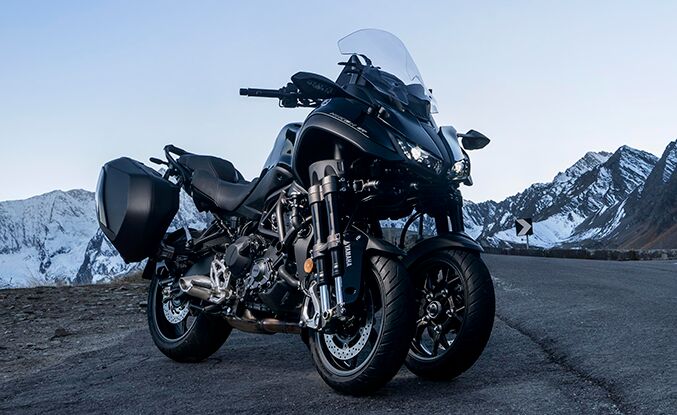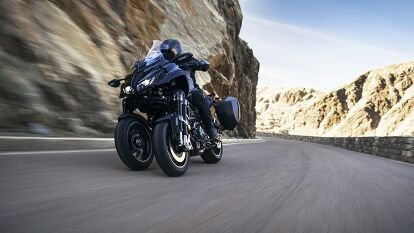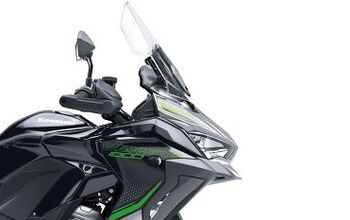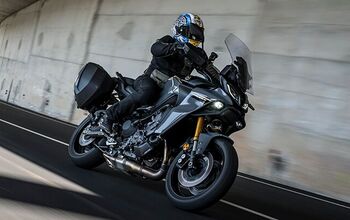2023 Yamaha Niken GT First Look

Bigger engine, new saddlebags, and updated electronics
This just in from Yamaha Europe, whether this applies Stateside remains to be seen:
For 2023, Yamaha has updated the Niken in just about every area of the bike. The high points include the engine, TFT functionality, and suspension. Since the company considers the Niken to be “one of Yamaha’s most sophisticated Sport Tourers,” the emphasis on improving the quality of the rider’s experience should come as no surprise.
The new 890cc EU5 engine features an increase of almost 5% displacement from the 78.0 x 62.1 mm for and stroke in the 12-valve Triple. Compression is 11.5:1. Yamaha also reshaped the crankshaft webs for in increased of 8% in mass designed to improve acceleration from a stop and tractability at low rpm. The engine itself is rotated 5° forward for optimal chassis balance, and it sports a redesigned crankcase. The radiator capacity also got bumped to handle the increased heat output from the larger engine. Yamaha has made no claims about power output other than to call it “a substantial upgrade to…performance.” The exhaust, while being worked over to meet Euro 5, now has improved ground clearance.
Controlling the engine becomes more natural in 2023 with the old cable and pulley system being replaced with the “Yamaha Chip Controlled Throttle (YCC-T) and ride-by-wire Accelerator Position Sensor Grip (APSG).” The quickshifter has been updated to operate in both directions. Of course, with the new engine comes new ride modes: Sport, Street, and Rain (with an 18% decrease in power output). The TC settings have also been modified to suit the new engine, and finally, the Niken will receive the John Burns Nod of Approval over the standard cruise control.
To tell the rider what the engine is doing, as well as a host of other informational items, the full-color, 7-in. TFT display has bee worked over. First, there are now three different screen themes which were designed to match different riding scenarios and rider preferences. The joystick on the left handlebar controls all screen activity, and at a stop, the Niken’s TFT can display everything from weather reports to detailed notifications. To accommodate this, smartphone connectivity has been updated for use with Yamaha’s free MyRide-Link app. Offering connection via three means, USB-cable, WiFi, or Bluetooth, information regarding calls, emails, and messages can be reviewed on-screen. Additionally, once paired with a Bluetooth headset, a Niken rider can listen to music and answer calls.
Big news for touring rides on the Niken is that, once the Garmin Motorise app has been downloaded to the phone, a navigation window can be displayed on the TFT. As with the other TFT functions, the app can be controlled by the joystick; however, this only works at a standstill. The Garmin Motorise app offers routing for fastest, shortest, highway, and more. Additionally, turn-by-turn directions can be sent to a paired Bluetooth headset.
Since the maps are downloaded to the phone, navigation still works when your travels leave the grid. Still, there are several other navigation features that should be mentioned: “real time traffic, estimated time of arrival, and alternative routes to avoid congestion – and real time updates display local weather information as well as the weather situation at the chosen destination.” Other data, including rider alerts for sharp bends and speed limits, is available. The only downside is that all this GPS functionality requires a subscription.
Yamaha also addressed creature comforts for 2023. First the new windscreen offers 2.8-in. adjustment via a lever located conveniently next to the new TFT. The new screen is claimed to direct turbulent air around the cockpit for a better riding experience. The updated seat is designed to ease the reach to the ground, thanks to its revised shape and padding.
Along with the new handlebar joystick mentioned above, the grips include heating as a standard feature. You can keep your electronics charged via a USB-A port, while a 12V outlet is available under the seat.
But what about handling, you ask? The frame was redesigned to handle the now engine’s 5° tilt and improve the handling. Additionally, the rear suspension received a new forged-aluminum shock linkage that not only saves 236g of weight, but also gives a smoother ride by combining with the “new rear shock settings and a smaller diameter shock spring, provides a smoother solo ride and gives firmer and effective rear suspension performance when riding with a passenger.”
Yamaha has not set prices at this time, but we’ll update as we learn more.
Become a Motorcycle.com insider. Get the latest motorcycle news first by subscribing to our newsletter here.

Like most of the best happenings in his life, Evans stumbled into his motojournalism career. While on his way to a planned life in academia, he applied for a job at a motorcycle magazine, thinking he’d get the opportunity to write some freelance articles. Instead, he was offered a full-time job in which he discovered he could actually get paid to ride other people’s motorcycles – and he’s never looked back. Over the 25 years he’s been in the motorcycle industry, Evans has written two books, 101 Sportbike Performance Projects and How to Modify Your Metric Cruiser, and has ridden just about every production motorcycle manufactured. Evans has a deep love of motorcycles and believes they are a force for good in the world.
More by Evans Brasfield












































































Comments
Join the conversation
This is looking good. The upgrades, and the black forks, new luggage etc.. - almost sexy. Would consider one for 2 up with the GF - just for her safety.
It’s hard to criticize something for just being different. Everybody says the Niken rides just like a conventional bike in which case Yamaha have done a great job, because to make something with that mass and complexity up front steer like a conventional bike cannot be easy. OfCourse for something that rides just like a conventional bike it does carry a considerable weight penalty and costs significantly more. So, apparently, what you get in return for those penalties is “stability” and superior grip/safety when road conditions are hazardous. Really? I cannot say that any of the bikes I still ride, or have ridden, ever felt less than stable on dry roads. I used to commute in the Seattle area so I have ridden many miles on wet roads and I remained safe by just taking it easy. I didn’t mind taking it easy, I wasn’t riding for pleasure, I was wet and miserable and I was going to work! I imagine that if I had a Niken I would still take it easy in the wet: may be a little less easy in recognition of the superior grip/safety, but I’m still not going to be voluntarily searching for the limit when commuting. How much safer is the Niken in the wet? You may have twice the front contact patch area, but you will not have anything like twice the grip.
I do feel a bit bad about criticizing the Niken when so many others seem to like it, but if the Niken solves a problem there has to be a more elegant way of doing it, ”If it looks right, it is right” and the Niken just isn’t.